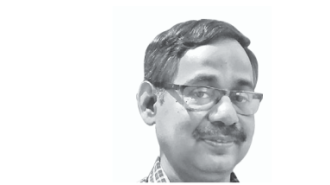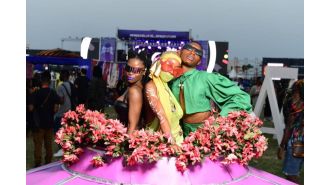Charleston Unveils Historical Marker at the Site of Firm That Held the Largest Known U.S. Slave Trade
Decades ago, Congress made a commitment to fund a higher education system for Indigenous communities. But a quarter-billion-dollar annual shortfall has led to crimped budgets and crumbling buildings, even as enrollment rises.

On a brilliant mid-October morning, Harold Singletary stood before a teal shroud hanging from a building along one of the most famed architectural stretches in downtown Charleston, South Carolina. A Black businessman, he never imagined he would be standing here, for this purpose, along a street he had walked countless times, not knowing.
He prepared to address a group gathered to unveil a historical marker that announced to anyone walking by that the finely restored antebellum structure behind him once housed an auction firm that in 1835 “conducted the largest known domestic slave sale in United States history.”
In all, 600 enslaved people were put up for sale.
The new marker is notable because these streets, once bustling with businesses critical to the slave trade, yield little of that story to the average passerby. Singletary grew up in this coastal city — once the nation’s busiest slave port — where racial atrocities went largely ignored by white locals until recently.
He held prepared remarks in one hand. But before speaking, he walked over to hug Lauren Davila, a stranger who in 2022 discovered an ad for the sale of 600 people when she was a College of Charleston graduate student. Last year, a ProPublica reporter traced the sale to a wealthy plantation operator named John Ball Jr., which enabled Singletary to connect his own family members to those sold — and opened the door to additional research into the fates of the 600 people advertised for sale.
Until Davila’s discovery, the largest known slave auction in the U.S. was one that was held over two days in 1859 just outside Savannah, Georgia, roughly 100 miles down the Atlantic coast from Charleston. At that auction, 436 people were sold.
A small group then spearheaded creation of the marker Singletary was prepared to unveil.
“This is a big moment in representing ancestors,” Singletary began. Among those sold by the auction firm housed here were the mother and grandparents of an ancestor Singletary so reveres that he named his business, BrightMa Farms, after her. Its corporate office sits a four-minute walk away.

“America has to face some hard facts,” Singletary said. “And those facts change stories that change narratives.” He thanked the people “who helped change the narrative.” Among them is the man who owns the salmon-colored building at 24 Broad Street and agreed to hang the marker on it.
Attorney Stephen Schmutz bought the two-story building in 1989 and has operated his law firm there since. He had no idea it once housed a notorious slave auction firm.
“I just started thinking of the irony of it all,” Schmutz said. He grew up in segregated schools. Until he attended law school, all of his classmates were white. But when he was a young man during the Civil Rights movement, men like Martin Luther King Jr. “opened my eyes to the injustice of segregation.”
Among others, Schmutz has represented families of those killed in the 2015 Emanuel AME Church massacre, in which a white supremacist murdered nine Black worshippers. Standing before the marker, he applauded work to compile a more honest accounting of the city’s history.
The marker, about 2 feet tall, reads: “SLAVE AUCTIONS OF THE DOMESTIC SLAVE TRADE.” The auction firm Jervey, Waring & White, which operated in the building from 1828 to 1840, was “part of a network of similar enterprises” around it that included banks and insurance companies, the marker explains.
The marker’s story began in March 2022 when Davila, now a doctoral student at Tulane University, was scouring newspaper archives from her home in Charleston. As part of an internship, she was logging ads for slave auctions.
On that day, she clicked on Feb. 24, 1835. From a sea of classified ads, she read:
“This day, the 24th instant, and the day following, at the North Side of the Custom-House, at 11 o’clock, will be sold, A very valuable GANG OF NEGROES, Accustomed to the culture of rice; consisting of SIX HUNDRED.” She was stunned.

But the ad she found was brief. It yielded almost no details beyond the size of the sale and where it would be held.
A ProPublica reporter then found the original ad for the sale, which ran more than two weeks earlier. Published on Feb. 6, 1835, it revealed that the sale of 600 people was part of the estate auction for John Ball Jr., scion of a slave-owning planter regime. Ball had died the previous year, and five of his plantations were listed for sale — along with the people enslaved on them.
A descendant of Ball’s named Edward Ball wrote a bestselling book in 1998, “Slaves in the Family,” which detailed his family’s skeletons and the horrors long minimized by a Lost Cause narrative of benevolent slave owners. Ball had located descendents of people his ancestors had enslaved — including Harold Singletary.
Davila’s research was supported by the College of Charleston’s Center for the Study of Slavery and a white Charlestonian named Margaret Seidler. At 65, Seidler had discovered notorious slave traders in her own family tree, and then she began identifying others — including Jervey, Waring & White.
Seidler wrote a book about her findings and has been reaching out to other white Charlestonians urging them to help provide an honest account of the city’s slave history. She and historian Bernard Powers, the Center for the Study of Slavery’s founding director, pushed for the marker.
“Truth can be a tonic,” she said.
ProPublica is a nonprofit newsroom that investigates abuses of power. Sign up for Dispatches, a newsletter that spotlights wrongdoing around the country, to receive our stories in your inbox every week.
ProPublica is a nonprofit newsroom that investigates abuses of power. Sign up for Dispatches, a newsletter that spotlights wrongdoing around the country, to receive our stories in your inbox every week.






